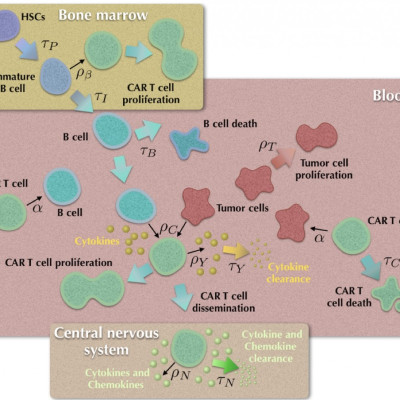Publication
CAR T cell therapy in B-cell acute lymphoblastic leukaemia: Insights from mathematical models
O. León-Triana, S. Sabir, G.F. Calvo, J. Belmonte-Beitia, S. Chulian, A. Martínez-Rubio, M. Rosa, A. Pérez-Martínez, M. Ramírez-Orellana, V.M. Pérez-García
Comm Nonlin Sci Numer Simul 94, 105570 (2021)
MOLAB authors
Abstract
Immunotherapies use components of the patient immune system to selectively target cancer cells. The use of CAR T cells to treat B-cell malignancies --leukaemias and lymphomas-- is one of the most successful examples, with many patients experiencing long-lasting complete responses to this therapy. This treatment works by extracting the patient's T cells and adding them the CAR group, which enables them to recognize and target cells carrying the antigen CD19+, that is expressed in these haematological tumors.
Here we put forward a mathematical model describing the time response of leukaemias to the injection of CAR T-cells. The model accounts for mature and progenitor B-cells, tumor cells, CAR T cells and side effects by incorporating the main biological processes involved. The model explains the early post-injection dynamics of the different compartments and the fact that the number of CAR T cells injected does not critically affect the treatment outcome. An explicit formula is found that provides the maximum CAR T cell expansion in-vivo and the severity of side effects. Our mathematical model captures other known features of the response to this immunotherapy. It also predicts that CD19+ tumor relapses could be the result of the competition between tumor and CAR T cells analogous to predator-prey dynamics. We discuss this fact on the light of available evidences and the possibility of controlling relapses by early re-challenging of the tumor with stored CAR T cells.















